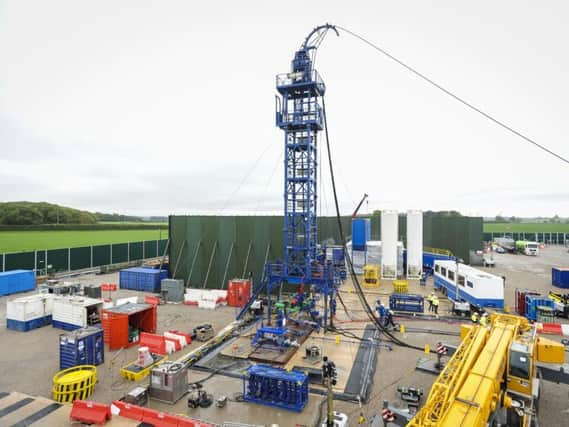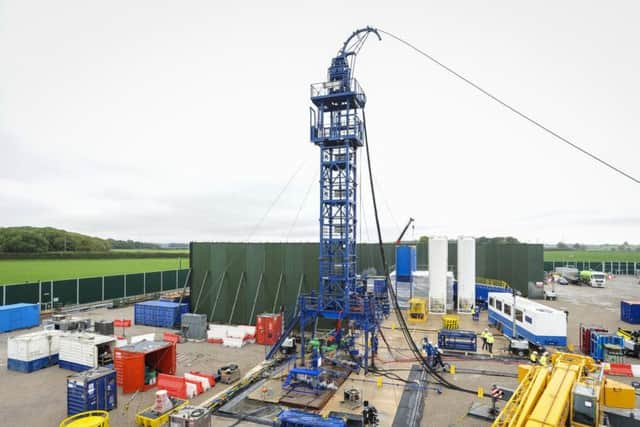Fracking halted again as biggest earthquake yet is recorded at Cuadrilla's new site in Lancashire


The British Geological Survey (BGS) noted four earthquakes from 11.30am until 11.58am, which the first measuring 1.1 on the magnitude scale. The others measured -0.2, -0.4, and 0.1.
In a statement, Cuadrilla said the "micro seismic event measuring 1.1ML (local magnitude) was detected" while fracking was taking place at its exploration site in Preston New Road, Little Plumpton.


Advertisement
Hide AdAdvertisement
Hide Ad"This is the latest micro seismic event to be detected by the organisation’s highly sophisticated monitoring systems and verified by the British Geological Survey (BGS)," it said.
"This will be classed as a ‘red’ event as part of the traffic light system operated by the Oil and Gas Authority but as we have said many times this level is way below anything that can be felt at surface and a very long way from anything that would cause damage or harm.
"In line with regulations, hydraulic fracturing has paused for 18 hours now, during which seismicity will continue to be closely monitored by ourselves and the relevant regulators. Well integrity has been checked and verified.”
Anti-fracking campaigners have voiced their alarm at the earthquakes, with 27 now noted since fracking started on Monday, October 15.
Advertisement
Hide AdAdvertisement
Hide AdThe government's traffic light system says fracking can continue as normal when tremors measuring under 0.0ML are recorded.
From 0.0 to 0.5, "injection proceeds with caution, possibly at reduced rates," guidance states. "Monitoring is intensified."
Those measuring over 0.5 results in the operator suspending fracking, reducing pressure, and monitoring ground movements for any further events before resuming.
Today marks the third time Cuadrilla has stopped fracking. It paused for the day after an amber quake last week, before stopping for 18 hours on Friday after a red quake.
Advertisement
Hide AdAdvertisement
Hide AdLancashire County Council's Labour group has called on the government to suspend fracking, claiming "this self-regulation does not appear to be reducing the size or frequency of these earthquakes".
It also wants the council's new chief executive, Angie Ridgewell, to write to Prime Minister Theresa May and call for an independent enquiry to investigate the 'quakes.
Labour's deputy leader Coun John Fillis said: "In order to assure local people, fracking should be suspended until the enquiry report has been published to enable everyone to consider its findings.
"This is not just about the Preston New Road fracking site. The government is supporting fracking right across Lancashire and is consulting on changing planning laws to prevent local people and councils from blocking these developments.
Advertisement
Hide AdAdvertisement
Hide Ad"The people of Lancashire deserve answers to their genuine concerns."
Cuadrilla has drilled two horizontal wells into deep lying Bowland Shale rock under its site, and is pumping water, sand, and chemicals down to make small fractures in the rock in the hope of releasing natural gas stored there.
That will then flow back to the surface to recovered for the national grid.
The firm said the process would take around three months to finish for both exploration wells. It will then test the flow of natural gas, with initial results expected in the new year.
Advertisement
Hide AdAdvertisement
Hide AdLittle Plumpton is Cuadrilla's first fracking site since two earthquakes in 2011 - measuring 2.3ML and 1.5ML - halted work at its Preese Hall site near Blackpool.
The BGS said 58 earthquakes were linked to fracking at Preese Hall between March 31 and August 30, 2011, and said "nearly all of these [were] either during or within a few hours of fracturing operations".
It said a study found that "the earthquake activity was caused by fluid injection directly into a nearby fault zone, which reduced the effective normal stress on the fault and caused it to fail repeatedly in a series of small earthquakes". It said a "possible causative fault was later identified" following a detailed 3D "seismic reflection study".
Gordon Marsden, Blackpool South's Labour MP, said: "As the tremors steadily increase, so does the distress and worry to local people.
Advertisement
Hide AdAdvertisement
Hide Ad"Government ministers need to get their heads out of the sand and urgently halt the fracking process.
"We need to find out what is going on below the surface at Preston New Road.
"It’s also about time someone from the Government actually visited the area so they can hear for themselves the concerns and fears of residents.”
And Rose Dickinson, Friends of the Earth campaigner, said: "People living nearby will understandably be worried.
Advertisement
Hide AdAdvertisement
Hide Ad"When is the government going to realise backing fracking was the wrong call for the people of Lancashire, our environment and climate, and put a stop to this risky industry once and for all?”
Lancashire For Shale said in a statement: "Local residents should not be concerned about today's microseismic event, which like the others before it could not be felt and could not possibly cause any harm or damage at the surface according to experts.
"The fact that the regulator is satisfied with Cuadrilla's ongoing well integrity checks and continues to allow fracking to proceed should also reassure people that the microseismicity we're seeing is not compromising any of the environmental protections that are in place.
"It's worth reflecting on the fact that quarry blasting operations, which occur much closer to the surface and therefore nearer to properties and infrastructure, produce much more noticeable ground motion effects and are subject to much higher regulatory limits than shale gas extraction, but are generally tolerated by their host communities."